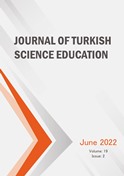Knowledge Elements Used by Pre-Service Primary Teachers to Explain Free Fall
Research Article
Keywords:
Physics education, free fall, phenomenological primitives (p-prims).Abstract
As well as knowledge structures can be complex and coherent, they might be small and disconnected. This study focuses on knowledge elements of pre-service teachers using diSessa’s phenomenological primitives (p-prims) framework. Based on group interviews, a test was developed regarding the knowledge fragments used for explaining free fall in three different contexts—the Earth, the Moon, and Mars—for both vertically released and kicked balls. The test was then implemented to 274 pre-service primary teachers. The results indicated that teacher candidates used six different p-prims such as force as a mover, closer means stronger, bigger is greater, overcoming, dynamic balance, and dying away to explain free fall. The use and appropriateness of p-prims differed due to context both qualitatively and statistically.
